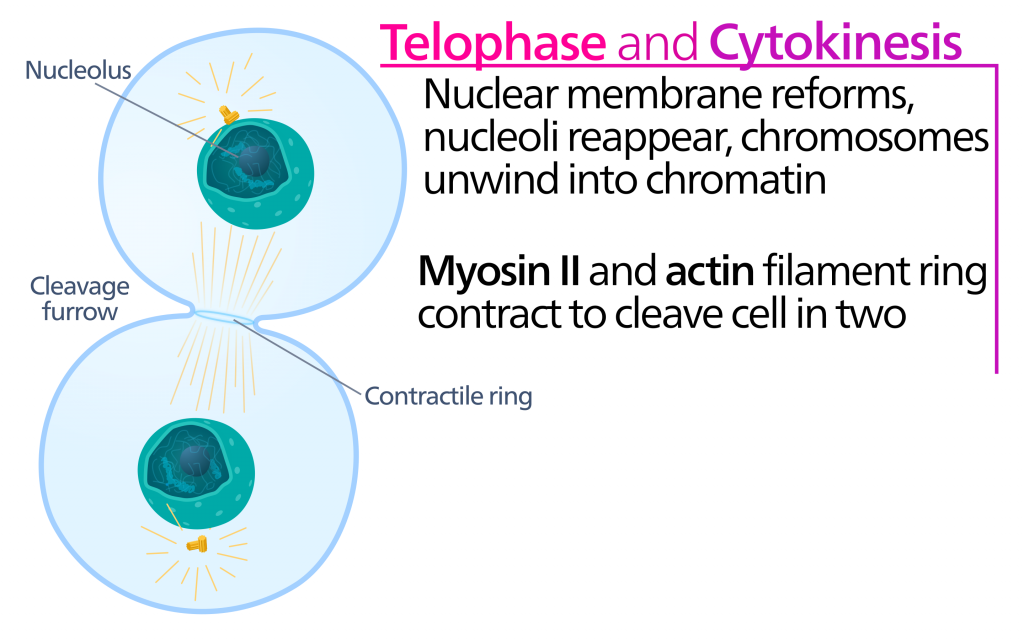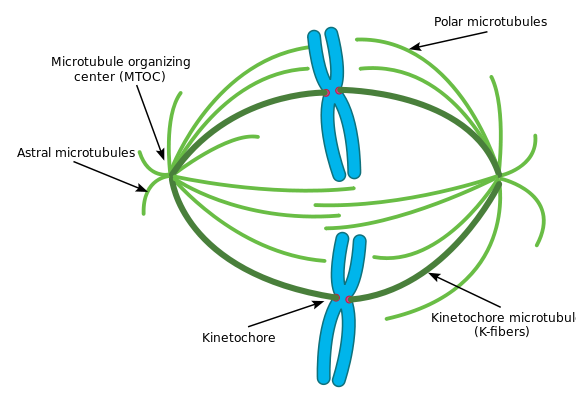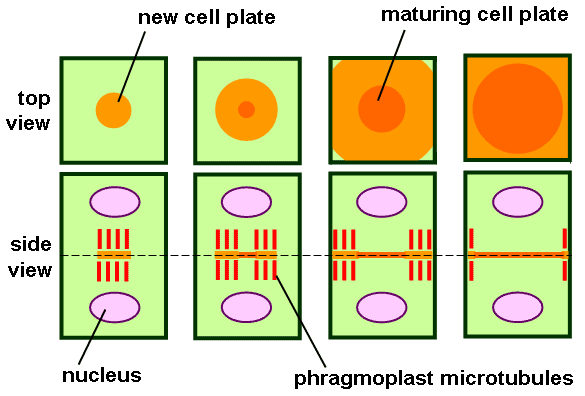How Does Cytokinesis Occur In A Animal Cell
What is Mitosis? A Recap
Mitosis is the process whereby a jail cell reproduces asexually to produce 2 identical girl cells. This occurs via nuclear division. Earlier mitosis, the number of chromosomes in the prison cell is doubled via chromosome replication, transforming the jail cell from a diploid (2n) jail cell to a tetraploid (4n) cell. This is to ensure that the chromosomal number is conserved throughout cell replication; if this did not occur, a diploid cell would carve up to produce a haploid cell, which would afterwards divide to contain merely half the number of chromosomes in the haploid, and then forth. Mitosis is important for jail cell replacement; for the development of embryos after sexual reproduction, and the growth of organisms afterward this stage; and for asexual reproduction. Mitosis is comprised of v main phases: prophase, prometaphase, metaphase, anaphase and telophase. Mitotic events are separated from each other by interphase, during which a cell is not in the process of dividing.
Prophase is characterized by the migration of centrioles from the centrosome, located just outside of the nucleus, to contrary ends of the cell in animal cells (plant and fungi cells practise not contain centrioles). While this is occurring the nuclear envelope and nucleolus within brainstorm to atomize to allow the chromatin within to dissever, thus forming the genetic footing of the two daughter cells. The chromatin condenses, and chromosomes become visible.
In prometaphase, the spindle fibers (formed past bundles of microtubules) adhere to the kinetochore at the center of each chromosome in preparation to dissever the sister chromatids. The chromosomes align on the equatorial plane of the cell. In metaphase, the chromosomes are all aligned on this plane, with the arms of a sis chromatid facing each pole.
Anaphase results in the disjunction of the chromosomes into sis chromatids, which are pulled to opposite poles via the shortening of spindle fibers. This continues into telophaseuntil there is a diploid number of chromosomes at each pole of the prison cell.
The entirety of mitosis upwardly until this point is known equally karyokinesis, which refers to the splitting of the nuclear material into genetically identical diploid sets. The cell so splits to course 2 genetically identical daughter cells, in a process known as cytokinesis. The end of cytokinesis denotes the end of telophase.
What is Cytokinesis?
Cytokinesis is the process whereby the cytoplasm of a parent prison cell is divided between two daughter cells produced either via mitosis or meiosis. This is also often known every bit cytoplasmic sectionalisation or cell cleavage. Cytokinesis begins in anaphase in animal cells and prophase in plant cells, and terminates in telophase in both, to course the two daughter cells produced by mitosis. In essence, cytokinesis is the partitioning of the cytoplasm into two equal parts, each of which comprise a diploid chromosomal set identical to that of the parent cell. One time this cytoplasmic material is divided, a plasma membrane (prison cell membrane) is formed around each new cell and organelles within the cytoplasm course through replication or synthesis. Becausethe cytoplasmic cloth is not doubled in mitosis, unlike nuclear material, the resulting girl cells are approximately half the book of the parent cell. Notwithstanding, the nucleus of each girl cell is roughly the same size as that of the parent cell, due to the chromosome replication which occurs before mitosis. Cytokinesis takes identify in four stages: initiation, contraction, membrane insertion and completion. The events occurring within these stages differ in beast and establish cells.

Image Source: Wikimedia Commons
Figure 1: Cytokinesis occurs in the tardily telophase of mitosis in an animal jail cell.
Cytokinesis in Fauna Cells
In animals, the cytoplasm is constricted in much the same way as a airship would be, until the constriction becomes so tight that the ii daughter cells are formed. This begins with the formation of a cell furrow or cleavage furrow, a puckering in the cell membrane enclosing the genetic material and cytoplasm. This puckering is caused by the formation of a contractile ring, formed of actin and myosin Ii filaments, every bit well equally proteins. The contractile ring is located just below the surface of the cell membrane.It initially forms at a point surrounding the equatorial plane of the cell and spreads around the circumference of the prison cell in a linear mode until the whole cell is encircled by a small furrow. This furrow and so deepens as the contractile ring contracts. Call back that the contractile ring is fabricated upwardly of actin and myosin II filaments, but like musculus tissue, which permit this contractile action. The additional membrane material is produced via vesicle fusion to business relationship for the increment in surface expanse that the cell membrane must enclose, and is inserted side by side to the contractile ring. The contractile ring continues to contract until the two daughter cells are separated by only a midbody, a narrowed portion of the cytoplasm connecting the 2 daughter cells and containing the remains of the mitotic spindle, earlier breaking off to form two girl cells completely enclosed in separate jail cell membranes. After cytokinesis, the organelles reassemble in each daughter prison cell. Some of these, such as mitochondria and chloroplasts, replicate from existing bodies. Others, such as the endoplasmic reticulum and Golgi apparatus, fragment when the nuclear envelope of the parent cell disintegrates, and these fragments regenerate whole organelles in the respective girl cells.
How Does the Contractile Ring Work?
The contractile band'south office and position are controlled by the spindle fibers or mitotic spindle – the aforementioned machinery controlling the movement of chromosomes in mitosis. The alignment of the mitotic spindle is perpendicular to that of the equatorial plane; that is the mitotic spindle stretches between the two diploid sets of chromosomes located at the poles of the prison cell, with the equatorial airplane between the poles. This is to prevent incorrect separation of the chromosomes during cytokinesis.
The actin and myosin II fuel the wrinkle of the contractile ring, in a chemic reaction similar to that which occurs in smooth muscle. The microtubules utilized in mitosis are used to stabilize the cell furrow as information technology increases in depth and latitude. The contractile ring dissipates once cleavage is complete.

Image Source: Wikimedia Commons
Effigy 2: The mitotic spindle drives the contractile ring creation and positioning in animal cells.
Cytokinesis in Plant Cells
In plants, cytokinesis begins with the production of a cell plate on the equatorial plane. This will later become the eye lamella betwixt the 2 constitute cells. Also the primary and secondary cell walls of each daughter prison cell are deposited on either side of the cell plate, forming the basis of the separation betwixt the two daughter cells.
Cytokinesis is initiated in prophase when a cytoskeleton of actin filaments and microtubules forms around the cell. This ring is known every bit the preprophase ring, and will later decide the positioning of the cell plate. The preprophase band is only present in prophase and prometaphase and disintegrates earlier mitosis reaches the metaphase stage. The cell plate begins to form in anaphase and is controlled past the phragmoplast, which contains the remains of the mitotic spindle. Microtubules within the mitotic spindle send vesicles containing polysaccharides and glycoproteins to the eye of the phragmoplast, where they fuse to course the early cell plate. This early on cell plate continues to expand until it reaches the parent cell membrane and cell wall, where it fuses with the cell wall. The location of this fusion is determined by the location of the preprophase ring. Cellulose is afterward laid downwards inside the early cell plate to create a cell wall, which will divide the parent cell into two girl cells of equal book and each containing a diploid set of chromosomes. These can increase in size via subsequently expansion or growth.
Please make sure to proceed track of the differences between cytokinesis plants and cytokinesis in animals. You might find it useful to tie these back to the differences in their cells.

Image Source: Wikimedia Commons
Figure iii: Cytokinesis in plant cells occurs from the inside-out, with the creation of a cell plate.
When Does Cytokinesis Occur?
In animal cells, cytokinesis begins in anaphase, with the mitotic spindle determining the starting position of the contractile ring to form. In telophase, this ring becomes active, and the cleavage furrow forms and deepens until simply a thin attachment, the midbody, remains. Cleavage is so completed, and cytokinesis ends.
In plant cells, cytokinesis begins in prophase, with the product of a cytoskeleton known as a preprophase band. This band disappears earlier metaphasebut is the point at which the new prison cell wall joins the parent cell wall. A cell plate is deposited at the eye of the parent prison cell, between the two sets of diploid chromosomes. This begins in anaphase. The mitotic spindle, contained inside the phragmoplast, controls the creation of this wall from vesicles. The wall continues to grow until information technology reaches the point in the parent cell wall determined by the preprophase band, forming two complete cells. Cytokinesis ends at the end of telophase.
When Things Go Wrong
Cytokinesis needs to occur at the right fourth dimension and identify, so that each daughter jail cell has a complete diploid set of chromosomes, and so that chromosome move is not interrupted. If cytokinesis occurs at the wrong fourth dimension or in the wrong place, it can lead to cells with an abnormal amount of chromosomes. This leads to conditions such as aneuploidy, where a cell has several extra or missing chromosomes; polyploidy, where cytokinesis does not occur and a cell has more than a diploid set of chromosomes; or multinucleated cells, where more than one nucleus is present in a prison cell. These tin can lead to genetic disordersor even cancers.
Cytokinesis does not occur in the process of mitosis leading to multinucleate cells. In this procedure, cytokinesis is skipped in favor of rapid evolution. This occurs in Drosophila, commonly known equally the fruit fly, embryos equally well as in certain types of mammalian cells, such as heart musculus cells and some liver cells, both of which need to exist regenerated rapidly.
In some occasions, the location of the contractile ring in brute cells and the prison cell plate in plant cells is not centered, leading to the creation of cells of unequal volumes or unequal cytoplasmic content. This is controlled through movement of the mitotic spindle and is used to create cells which will serve dissimilar functions, such equally the division of a fertilized egg cell in meiosis.
In conclusion, clearly cytokinesis is central to mitosis and therefore to the maintenance of the Eukaryota taxon. Understanding cytokinesis is essential to fully appreciating biology.
Let's put everything into practice. Try this Biology practice question:
 Looking for more than Biology practice?
Looking for more than Biology practice?
Bank check out our other articles on Biological science.
You can also find thousands of practise questions on Albert.io. Albert.io lets you customize your learning experience to target practice where you need the almost help. We'll requite you challenging practice questions to help you lot reach mastery in Biology.
Kickoff practicing hither .
Are you a teacher or administrator interested in boosting Biology student outcomes?
Learn more than most our school licenses here.
Source: https://www.albert.io/blog/when-does-cytokinesis-occur-in-mitosis/
Posted by: fredericksbarpries.blogspot.com

0 Response to "How Does Cytokinesis Occur In A Animal Cell"
Post a Comment